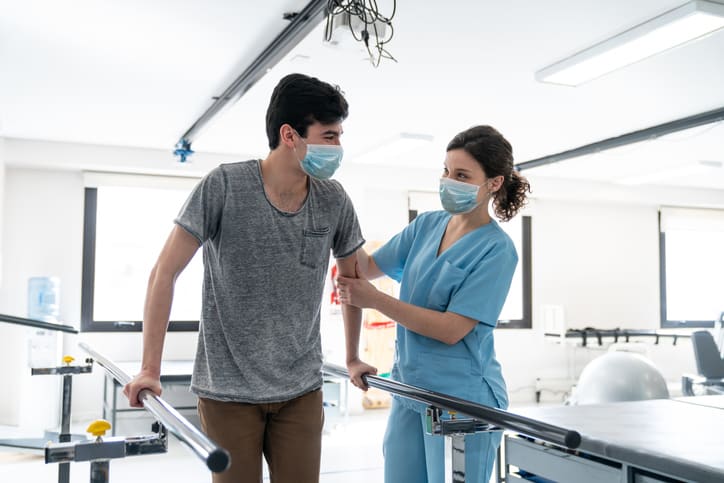
The lack of visitors allowed into hospitals is distinctly negative, here’s why:
Since the United States began dealing with the Coronavirus pandemic, specific states and Governors initiated their individualized schedules for lockdown, with the first two states starting in March, on the 19th and 22nd respectively. One of the last states to go into lockdown was Georgia, implementing measures on the 3rd of April 2020. With the initiation of lockdown, patient visitors in clinics, hospitals, Emergency Rooms, and nursing home facilities have been prevented from staying with loved ones.
As of this writing, coronavirus has claimed nearly 118,000 lives, and infected over 2,148,651 people within the United States, with 444,000 deaths and over 8.2 million infections across the globe. Several countries, i.e. especially in Latin America, report rising infections and increasing death tolls. As a result of troubling statistics, only a few hospitals/hospital systems across the continental United States have begun “opening up” visitation for hospitalized patients, even though restaurants, bars, and tattoo parlors began the reopening process by Memorial Day in select states.
Restarting Visitation
The reopening process for hospital visitation, like state reopening, has been staggered and dissimilar. A few hospital systems have begun structured, “stepped” visitation, while others remain rigidly closed to visits. Overall, it has been disheartening.
An example of a hospital system that has allowed patient visitation to restart is Hartford HealthCare (HHC), throughout Connecticut. This system began a phased-in program, but it started only in specific zones of their facilities, such as peri-procedural and surgical regions, e.g. cardiac surgery units. The infection control process was stringent. Visitors were tested for Covid-19 before visiting was allowed, to rule-out the presence of viral infection. Additionally, visitors had to stay masked, and either be in a patient room, or in a modified waiting area that allowed for physical distancing. After this preliminary step was completed, acute and ambulatory care units followed.3
Only one visitor per patient was allowed, including one visitor per room in semi-private rooms, to maintain adequate social distancing. Visitors had to be older than 16 years of age. Per state requirements, the senior facilities will remain visitor-free until September 8, 2020.3
An Unsettling Event
The Hartford Healthcare System must be commended for their thoughtful approach of integrating visitation back into the lives of patients, however not all facilities have leapt onto the bandwagon! Many have continued with draconian measures, forcing patients to undergo traumatic experiences alone or being connected only via video chatting (if even that service is available).
My own system has not yet opened visitation, and patients are required to check in for outpatient services independently. This not only requires additional time (and frustration) waiting at the entrance, it also adds distress for patients who require a helping hand (or shoulder!) for stabilization when weighing-in prior to an infusion. Additionally, during a recent trip, I witnessed a woman new to immunoglobulin treatment experience concern during her infusion. While I find the therapy lengthy and inconvenient, for newcomers it can be unsettling.
She was near me, but I was not able to comfort her. She cried during the IV start, and her tears were troubling. She was also nauseated, and quickly complained of chest pain moments after the infusion was started. Since she had no family with her to provide history, she needed to stipulate a few details as nurses debated the plan. Soon, they realized she needed an ambulance; her history suggested the pain was probably cardiac in origin. As I watched her being bundled up and whisked away, I realized how much we needed visitors to comfort her, to be with her, and to provide solace.
Visitors, OMG, how we need them! When I reflect on the nearly 118,000 lives lost to coronavirus and how many of those individuals passed without the comfort of a loved one to hold their hand or hug them, it nearly takes my breath away.
Visitation Clarified
The idea of patient visitors being pivotal in decision-making is one that ex-President Barack Obama discussed in 2010 while amending the Patient Bill of Rights to include “visitors who shall receive the same visitation privileges as the patient’s immediate family members, regardless of whether the visitors are legally related to the patient.” This important step allowed for patients to designate the person they felt would know them best and assure they would be their designee during a time of need, through use of a durable power of attorney for healthcare (DPAHC), or by the use of assigning a spokesperson for care.2
But in the years between 2010 and the onset of the novel coronavirus, there must be a compromise for allowing visitors during a time of viral disease, for as F. Scott Fitzgerald has written, “the loneliest moment in someone’s life is when they are watching their whole world fall apart, and all they can do is stare blankly.” This may be how patients feel without a loved one or friend to console or comfort them or to wile away the hours when they are feeling vulnerable and in pain while hospitalized.4
Planning for Visitation
Planning to restart patient visitation in all fifty states has been as individualized as the process of lockdown, only in reverse. At this time, 21 states are reporting increasing rates of coronavirus infections, 21 states are reporting decreasing rates, one state (Vermont) has decreased the rate of infection by 50%, and 8 states have relatively stable rates of disease. As a result, Governors have been advising hospitals and hospital systems within their states how to proceed.
A second example of a healthcare system where infection control has been carefully considered as visitors were resumed was the Ballard Health System in Tennessee. They resumed limited visitation on May 26th, with hours from 0800-2000. One visitor at a time was allowed in specific areas of their facilities, but again, the designated visitor needed to be Covid-19 negative before visitation could occur. Visitors at their facility must be at least 18 years of age. Visitors without a face covering would not be allowed. For Covid-19 patients (inpatients) or to rule-out Covid-19, no visitation would be permitted unless specific end-of-life situations occur.1
This is another example of a hospital system with a strong commitment to patient service and infection control during a pandemic.
Conclusion
As stated in Medscape, “we must care about this.” “We must address this issue and challenge the current dogma”…before another woman cries while her IV is inserted, or experiences chest pain while no one is there to hold her hand, or to console her or wipe away her tears. We must fight to have the one who knows us best by our side when we are vulnerable, so we do not spend the loneliest moments of our lives being totally alone, staring blankly.4
Websites:
- Balladhealth.org “Ballad Health to lift certain visitation restrictions beginning May 26.”, May 25, 2020, BalladHealth.org.
- Healthleadersmedia.com “Obama calls for lifting hospital visitor restrictions.”, jsimmons@healthleadersmedia.com, April 16, 2010.
- Healthnewshub.org “New visitor guidelines: Hospital restrictions eased.” McDonald, S., June 4, 2020, Hartford Healthcare.
- Medscape.com “Let’s stop the draconian visiting restrictions,” Alsaigh, T., May 27, 2020, Medscape Internal Medicine Perspective.






